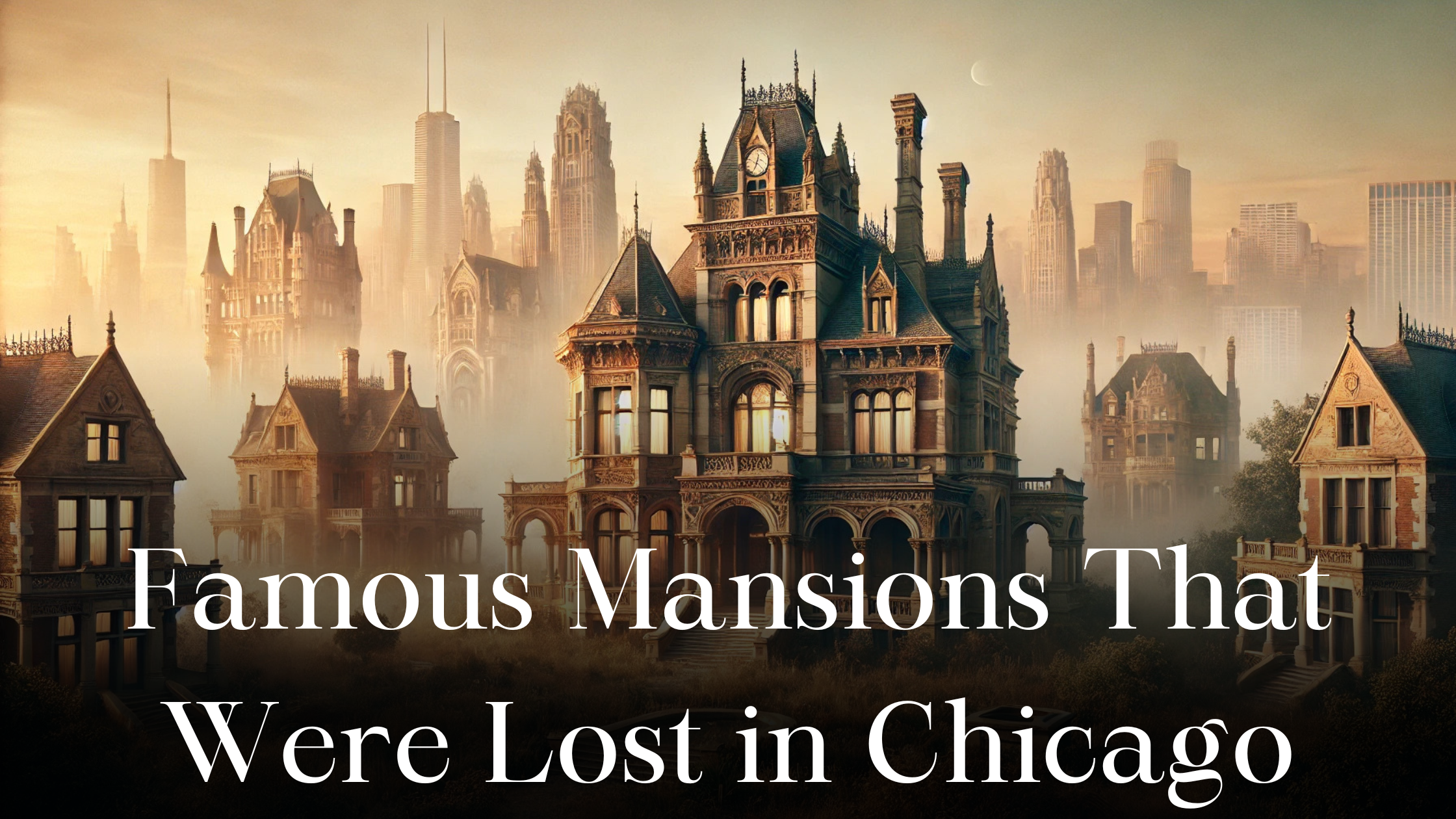Chicago has a rich history filled with stunning architecture and grand mansions, many of which have been lost to time. The city once boasted magnificent homes belonging to wealthy figures like Marshall Field and George Pullman, but many of these landmarks were sadly demolished. Today, the stories of these lost mansions serve as a reminder of the opulence that once thrived in the Gilded Age.
Exploring the tales behind these iconic buildings reveals the cultural and social dynamics of their time. Each mansion had its unique charm and significance, contributing to Chicago’s architectural legacy. Readers will discover the fascinating history of these structures and the reasons behind their disappearance.
As they delve into this topic, they’ll be captivated by the blend of elegance and loss that defines these once-great homes. Chicago’s lost mansions not only tell stories of architectural beauty but also reflect the changing city landscape over the years.
The History of Chicago’s Mansions
Chicago’s mansions reflect a rich history shaped by architectural trends and prominent families. These majestic homes showcase the grandeur of a past era and tell stories of wealth and style.
Architectural Evolution
Chicago’s mansion architecture evolved significantly from the late 19th to early 20th centuries. Initially, many homes featured the Victorian style, known for its ornate details and vibrant colors.
As the city grew, so did the designs. The Gilded Age brought in Beaux-Arts and Neoclassical styles, featuring symmetrical shapes and elaborate facades. Notable examples included the impressive structures along Prairie Avenue, built for affluent families.
Mansions were not just homes; they represented status and sophistication. Many showcased intricate woodwork, grand staircases, and expansive gardens. As time passed, though, many of these splendid homes were lost, making way for modern developments.
Prominent Families and Their Homes
Several influential families left their mark on Chicago’s mansion landscape. The Fields, known for the famous Marshall Field department store, built a lavish mansion between 1873 and 1876. This home was among the first to feature modern amenities of its time.
Another notable family was the Pullmans, who created their own community near the railroad they controlled. Their grand residence symbolized their wealth and status.
These families shaped not only the architecture but also the culture of Chicago. Their homes were venues for lavish parties and social gatherings that influenced the city’s elite. Many of these historic mansions have since been lost, but their legacy endures in Chicago’s architectural narrative.
Factors Leading to Loss
Several key issues contributed to the loss of famous mansions in Chicago. Urban development, economic changes, and unfortunate disasters all played significant roles in this trend.
Urban Development
As Chicago grew, urban development became a priority. Many historic mansions were demolished to make way for new buildings and commercial spaces. This rapid expansion often prioritized profit over preservation.
Residential areas were transformed into bustling commercial districts. The demand for housing also led to the loss of grand homes as they were replaced by apartment complexes.
Some iconic structures, like those on North Lake Shore Drive, fell victim to this trend. Developers saw valuable land and large properties as opportunities for modern construction, leading to the disappearance of architectural treasures.
Economic Changes
Economic shifts significantly impacted Chicago’s affluent neighborhoods. The Great Depression and later recessions caused many wealthy residents to leave the city.
With fewer wealthy citizens, maintenance and preservation of mansions became harder. Many owners chose to sell or demolish their homes rather than incur the costs of upkeep.
Property taxes and rising costs also pressured owners. This often resulted in the abandonment of once-splendid residences, further contributing to their loss.
Fires and Disasters
Fires and natural disasters had a lasting impact on Chicago’s historic mansions. Many homes suffered severe damage from fires, either accidental or due to neglect.
In some cases, a lack of resources made repairs impossible. The decision to rebuild was often influenced by economic factors.
Weather events, like harsh winter storms, could also damage these already aging homes. This increased vulnerability led to more demolitions as owners faced overwhelming costs to restore what was lost.
Iconic Mansions: A Closer Look
Chicago was home to several grand mansions that stood as symbols of wealth and power. These iconic homes showcased unique architectural styles and were linked to notable figures in history. Understanding these lost treasures offers a glimpse into the city’s rich past.
The Leiter Mansion
The Leiter Mansion was a stunning example of the Queen Anne style in the late 19th century. Built for the successful businessman and merchant, Levi Leiter, its intricate design included ornate woodwork and a grand entrance.
This mansion was located at 2100 S. Michigan Avenue and featured expansive gardens that showcased rare plants. Sadly, in the 1920s, the mansion was torn down to make way for more modern developments, erasing a piece of architectural history.
The Nickerson House
The Nickerson House, built in 1883, was known for its lavish interior and beautiful gardens. Designed for real estate magnate John Nickerson, the home included fourteen rooms filled with stunning artwork and antique furnishings.
Located at 40 E. 21st Place, it was one of the last grand residences left in the area. Unfortunately, it was demolished in the 1970s, marking the end of an era for Chicago’s historic mansions.
The Pullman Mansion
The Pullman Mansion was linked to George Pullman, a famous railroad magnate who revolutionized luxury travel. Completed in 1872, the mansion was known for its impressive architecture and opulent decor.
Set in the Pullman neighborhood, it featured a grand stairway and lavish rooms. It was destroyed in the 1950s, alongside many other historic residences, as developers pursued new projects.
Preservation Efforts
Efforts to maintain Chicago’s historic mansions are vital for preserving the city’s rich architectural legacy. Two key organizations play significant roles in these preservation activities: Preservation Chicago and the Chicago Architecture Foundation.
Preservation Chicago
Preservation Chicago is an active advocacy group dedicated to saving the city’s historic buildings. Founded in 2000, it aims to protect significant structures from demolition and neglect. The organization conducts outreach to raise awareness about Chicago’s architectural heritage.
They organize educational events, tours, and advocacy campaigns. An example of their success includes the preservation of the Glessner House, saved from demolition due to dedicated efforts. They engage with community members to promote the importance of historic preservation, ensuring that Chicago’s unique character endures.
Chicago Architecture Foundation
The Chicago Architecture Foundation, now known as the Chicago Architecture Center, has a strong commitment to preserving the city’s architectural treasures. They provide educational programs that explore the history and significance of Chicago’s famous structures.
The foundation offers guided tours and exhibitions that celebrate both past and present architecture. They played a crucial role in the preservation of Prairie Avenue’s mansions, working with local stakeholders to prevent further losses. Their initiatives help instill pride in the city’s rich architectural narrative, fostering a sense of community among residents.
Mansions Today
Many of Chicago’s historic mansions have transformed over the years. While some are now private residences, others serve as public museums or event spaces. Each type plays a unique role in preserving the city’s rich history.
Private Residences
Some of the mansions that once belonged to the city’s elite are still private residences. These homes often feature stunning architecture and expansive grounds. Owners appreciate the character and history that these homes bring.
Residents take great pride in maintaining the original elements, such as intricate moldings and vintage fixtures. Living in a mansion allows them to enjoy both comfort and a sense of history in their daily lives.
Public Museums and Event Spaces
Several former mansions have been repurposed as public museums or event spaces. One notable example is the Glessner House, which showcases the design and lifestyle of the Gilded Age. Visitors can explore its unique architecture and exhibits.
Other mansions host weddings, corporate events, and social gatherings. These venues attract people who wish to celebrate in a setting rich with history and elegance. Many also provide educational programs, connecting visitors to Chicago’s past.

